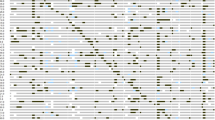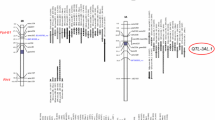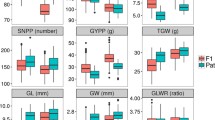Abstract
Two sets of rice materials, 166 RILs derived from a cross between Milyang 23 (Korean indica-type rice) and Tong 88-7 (japonica Rice), and BC1F1 hybrids derived from crosses between the RILs and the female parent, Milyang 23, were produced to identify QTLs for heterosis of yield and yield-related traits. The QTLs were detected from three different phenotype data sets including the RILs, BC1F1 hybrids, and mid-parental heterosis data set acquired from the definition of mid-parental heterosis. A total of 57 QTLs were identified for nine traits. Of eight QTLs detected for yield heterosis, five overlapped with other heterosis QTLs for yield-related traits such as spikelet number per panicle, days to heading, and spikelet fertility. Four QTLs for yield heterosis, gy1.1, py6, gy10, and py11, were newly identified in this study. We identified a total of 17 EpQTLs for yield heterosis that explain 21.4 ∼ 59.0 % of total phenotypic variation, indicating that epistatic interactions may play an important role in heterosis.
Similar content being viewed by others
References
Birchler JA, Auger DL and Riddle NC (2003) In search of the molecular basis of heterosis. Plant Cell 15: 2236–2239
Birchler JA, Yao H and Chudalayandi S (2006) Unraveling the genetic basis of hybrid vigor. Proc. Natl. Acad. Sci. USA 103:12957–12958
Bruce AB (1910) The Mendelian theory of heredity and the augmentation of vigor. Science 32: 627–628
Chen J, Ding J, Ouyang Y, Du H, Yang J, Cheng K, Zhao J, Qiu S, Zhang X et al. (2008) A triallelic system of S5 is a major regulator of the reproductive barrier and compatibility of indica-japonica hybrids in rice. Proc. Natl. Acad. Sci. USA 105: 11436–11441
Chin JH, Kim JH, Jiang W, Chu SH, Woo MO, Han L, Brar D and Koh HJ (2007) Identification of subspecies-specific STS markers and their association with segregation distortion in rice (Oryza sativa L.). J. Crop Sci. Biotech. 10: 175–184
Davenport CB (1908) Degeneration, albinism and inbreeding. Science 28: 454–455
Davis MD and Rutger JN (1976) Yield of F1, F2 and F3 hybrids of rice (Oryza sativa L.). Euphytica 25: 587–595
East EM (1908) Inbreeding in corn. Conn. Agric. Exp. Sta. Rpt. 1907: 419–428
Hochholdinger F and Hoecker N (2007) Towards the molecular basis of heterosis. Trends Plant Sci. 12: 427–432
Hua J, **ng Y, Wu W, Xu C, Sun X, Yu S and Zhang Q (2003) Single-locus heterotic effects and dominance by dominance interactions can adequately explain the genetic basis of heterosis in an elite rice hybrid. Proc. Natl. Acad. Sci. USA 100: 2574–2579
Hua JP, **ng YZ, Xu CG, Sun XL, Yu SB and Zhang Q (2002) Genetic dissection of an elite rice hybrid revealed that heterozygotes are not always advantageous for performance. Genetics 162: 1885–1895
Jiang W, Chu SH, Piao R, Chin JH, ** YM, Lee J, Qiao Y, Han L, Piao Z and Koh HJ (2008) Fine map** and candidate gene analysis of hwh1 and hwh2, a set of complementary genes controlling hybrid breakdown in rice. Theor. Appl. Genet. 116: 1117–1127
Jones DF (1917) Dominance of linked factors as a means of accounting for heterosis. Proc. Natl. Acad. Sci. USA 3: 310–312
Jones WJ (1926) Hybrid vigor in rice. J. Amer. Soc. Agron. 18: 423–428
Kim KH and Heu MH (1979) A study on heterosis in crosses between semi-dwarf rice cultivars. Kor. J. Breed. 11: 127–132
Kosambi DD (1943) The estimation of map distances from recombination values. Ann. Hum. Genet. 12: 172–175
Kusterer B, Muminovic J, Utz HF, Piepho HP, Barth S, Heckenberger M, Meyer RC, Altmann T and Melchinger AE (2007) Analysis of a triple testcross design with recombinant inbred lines reveals a significant role of epistasis in heterosis for biomass-related traits in Arabidopsis. Genetics 175: 2009–2017
Li L, Lu K, Chen Z, Mu T, Hu Z and Li X (2008) Dominance, overdominance and epistasis condition the heterosis in two heterotic rice hybrids. Genetics 180: 1725–1742
Li ZK, Luo LJ, Mei HW, Wang DL, Shu QY, Tabien R, Zhong DB, Ying CS, Stansel JW, Khush GS and Paterson AH (2001) Overdominant epistatic loci are the primary genetic basis of inbreeding depression and heterosis in rice. I. Biomass and grain yield. Genetics 158: 1737–1753
Li ZK, Pinson SR, Park WD, Paterson AH and Stansel JW (1997) Epistasis for three grain yield components in rice (Oryza sativa L.). Genetics 145: 453–465
Lin SC and Yuan LP (1980) Hybrid rice breeding in China. In: IRRI (ed) Innovative approaches to rice breeding. IRRI, Manila, Philippines, p 35–51
Lippman ZB and Zamir D (2007) Heterosis: revisiting the magic. Trends Genet. 23: 60–66
Liu KD, Zhou ZQ, Xu CG, Zhang Q and Saghai Maroof MA (1996) An analysis of hybrid sterility in rice using a diallel cross of 21 parents involving indica, japonica and wide compatibility varieties. Euphytica 90: 275–280
Luo LJ, Li ZK, Mei HW, Shu QY, Tabien R, Zhong DB, Ying CS, Stansel JW, Khush GS and Paterson AH (2001) Overdominant epistatic loci are the primary genetic basis of inbreeding depression and heterosis in rice. II. Grain yield components. Genetics 158: 1755–1771
McCouch SR, Cho YG, Yano M, Paul E, Blinstrub M, Morishima H and Kinoshita T (1997) Report on QTL nomenclature. Rice Genet. Newsl. 14: 11–13
Mei HW, Li ZK, Shu QY, Guo LB, Wang YP, Yu XQ, Ying CS and Luo LJ (2005) Gene actions of QTLs affecting several agronomic traits resolved in a recombinant inbred rice population and two backcross populations. Theor. Appl. Genet. 110: 649–659
Powers L (1945) An expansion of Jones’s theory for the explanation of heterosis. Am. Nat. 78: 275–280
Rogers SO and Bendich AJ (1988) Extraction of DNA from plant tissues. Plant Mol. Biol. Man. 6: 1–10
Saini SS, Kumar I and Gagneja MR (1974) A study on heterosis in rice (Oryza sativa L.). Euphytica 23: 219–224
Schnell FW and Cockerham CC (1992) Multiplicative vs. arbitrary gene action in heterosis. Genetics 131: 461–469
Shull GF (1908) The composition of a field of maize. Rep. Am. Breed. Assoc. 5: 51–59
Stam P (1993) Construction of integrated genetic linkage maps by means of a new computer package: Join Map. Plant J. 3:739–744
Stuber CW (1994) Heterosis in plant breeding. Plant Breed. Rev. 12: 227–251
Wang DL, Zhu J, Li ZKL and Paterson AH (1999) Map** QTLs with epistatic effects and QTL x environment interactions by mixed linear model approaches. Theor. Appl. Genet. 99: 1255–1264
**ao J, Li J, Yuan L and Tanksley SD (1995) Dominance is the major genetic basis of heterosis in rice as revealed by QTL analysis using molecular markers. Genetics 140: 745–754
Yu SB, Li JX, Xu CG, Tan YF, Gao YJ, Li XH, Zhang Q and Saghai Maroof MA (1997) Importance of epistasis as the genetic basis of heterosis in an elite rice hybrid. Proc. Natl. Acad. Sci. USA 94: 9226–9231
Yuan L (1994) Increasing yield potential in rice by exploitation of heterosis. In: Virmani SS (ed) Hybrid rice technology: New developments and future prospects. International rice research institute, Manila, Philippines, p 1–6
Yuan L (2004) Hybrid rice technology for food security in the world Procedings of the FAO rice conference, Rome, Italy
Yuan L and Virmani SS (1988) Status of hybrid rice research and development. In: IRRI (ed) Hybrid rice, IRRI, Manila, Philippines
Zhang Q, Liu KD, Yang GP, Maroof MAS, Xu CG and Zhou ZQ (1997) Molecularmarker diversity and hybrid sterility in indica-japonica rice crosses. Theor. Appl. Genet. 95: 112–118
Author information
Authors and Affiliations
Corresponding author
Rights and permissions
About this article
Cite this article
Chu, SH., Jiang, W., Lee, J. et al. QTL analyses of heterosis for grain yield and yield-related traits in indica-japonica crosses of rice (Oryza sativa L.). Genes Genom 34, 367–377 (2012). https://doi.org/10.1007/s13258-011-0223-x
Received:
Accepted:
Published:
Issue Date:
DOI: https://doi.org/10.1007/s13258-011-0223-x




